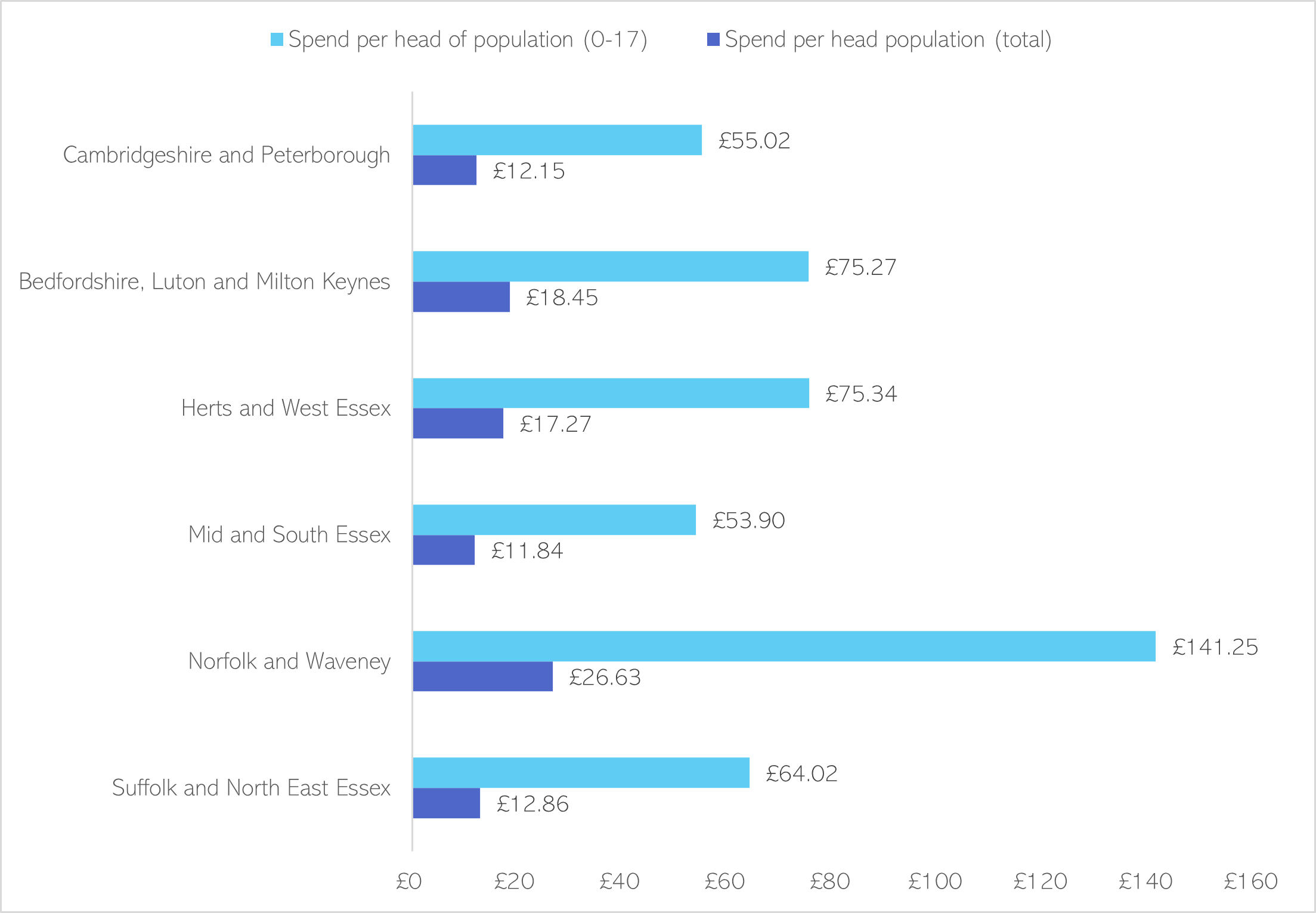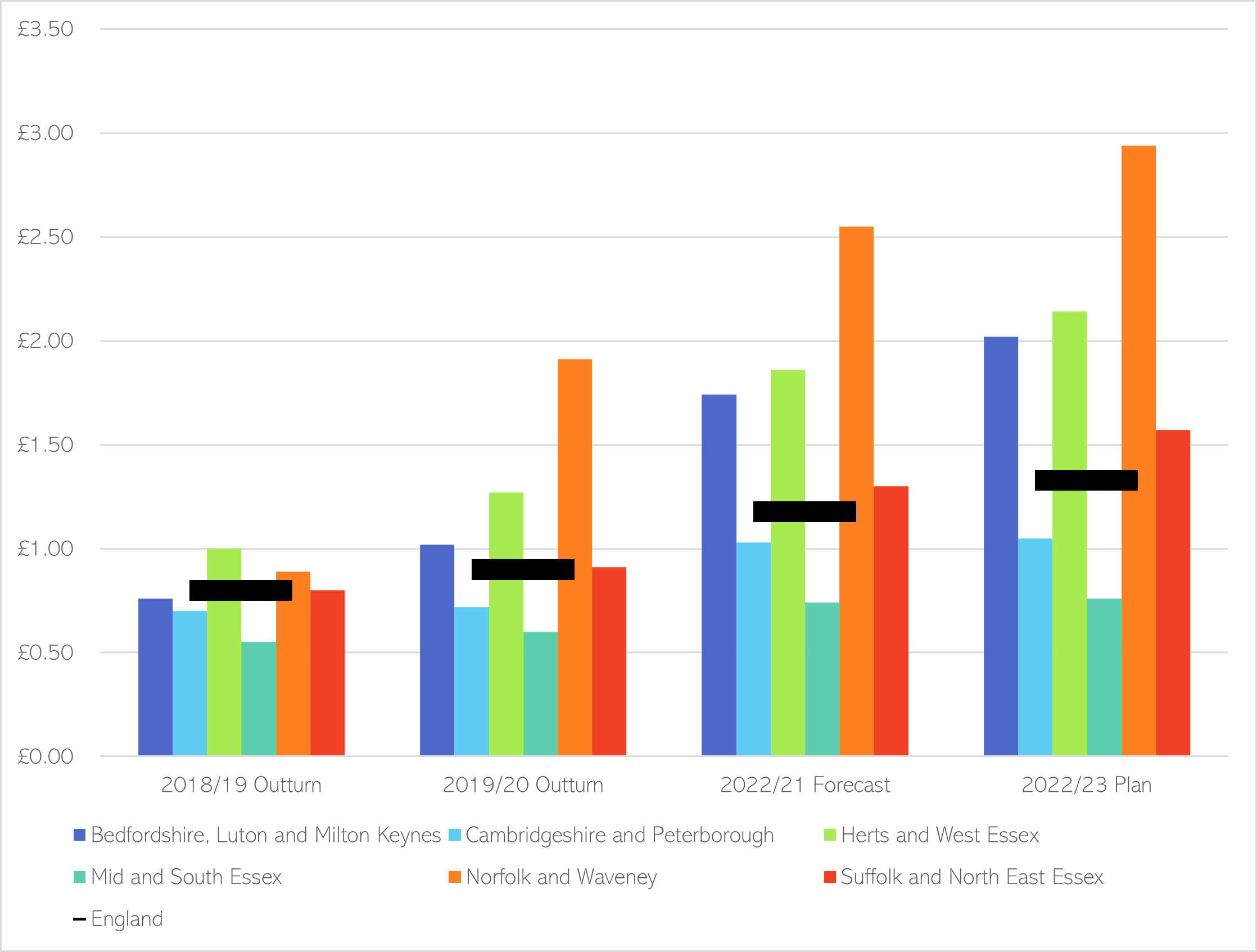Funding
- Per head spending on mental health services for children and young people in Cambridgeshire and Peterborough has been lower than the national average and other integrated care systems in the East of England in recent years.
- Cambridgeshire and Peterborough spent less than the regional average on Youth Justice and Children’s and Families Services in 2020/21. Cambridgeshire spent substantially lower than the regional average on services for children in care in 2020/21.
Funding for mental health services
Analysis of the Dataset for Mental Health Planning 2022/23 shows that spend per head of the total population in Cambridgeshire and Peterborough on children and young people’s mental health is lower than other integrated care systems in the East of England. Although spending on children and young people’s mental health within Cambridgeshire and Peterborough is increasing over time, it is also consistently lower than the national average. The full analysis can be found here.
Figure 34: Integrated care board spend per head of total population on Children and Young People’s Mental Health (excluding learning disabilities and eating disorders), 2018/19 – 2022/23. Source: Mapping spend across children and young people’s mental health services Cambridgeshire and Peterborough
Office for National Statistics (ONS) mid-2020 population estimates were used to calculate per head spend by the population of children and young people (aged 0 to 17). This analysis found that spend per head in Cambridgeshire and Peterborough is lower than most integrated care systems in the East of England.
Figure 35: Integrated care board spend per head of 0-17 and total population on Children and Young People’s Mental Health (excluding learning disabilities and eating disorders), 2021/22. Data source: Mapping spend across children and young people’s mental health services Cambridgeshire and Peterborough
Similarly, spend per head on children and young people’s eating disorder services in Cambridgeshire and Peterborough is lower than most other integrated care systems in the East of England and the national average.
Figure 36: Children and Young People’s Mental Health ICB spend on eating disorders, per head of total population, 2018/19 – 2022/23. Source: Mapping spend across children and young people’s mental health services Cambridgeshire and Peterborough
Funding for youth services
In the East of England, the planned spend on Family Support Services, Children and Young People’s Safety and children in care was lower than the national average in 2021/22.
Figure 37: Planned spend for East of England relative to the national average, 2021/22. Image source: Cambridgeshire and Peterborough Children and Young Persons Mental Health ICS Data Insight Pack (June 2022). Data source: LG Inform. Note that: ‘services for young people’ includes support for young people who use substances, young parents and other vulnerable teenagers; ‘other children’s and families services’ includes counselling and grants to voluntary organisations, ‘family support services’ includes support for family interventions and disabled children, and ‘Children Looked After’ includes residential care, fostering, adoption and leaving care support.
Spending on Youth Justice and Children’s and Families Services per child population (0-17) is lower than the regional average in Cambridgeshire and Peterborough. Cambridgeshire spends substantially lower than the regional average on services for children and young people in care.
Figure 38: Per child (0-17) spending in Cambridgeshire and Peterborough, relative to the East of England average, 2021/22. Image source: Cambridgeshire and Peterborough Children and Young Persons Mental Health ICS Data Insight Pack (June 2022). Data source: LG Inform. Note that: ‘services for young people’ includes support for young people who are NEET, substance use, young parents and other vulnerable teenagers; ‘other children’s and families services’ includes counselling and grants to voluntary organisations, ‘family support services’ includes support for family interventions and disabled children, and ‘Children Looked After’ includes residential care, fostering, adoption and leaving care support.
References
Full list of references is included at the end of this chapter.





